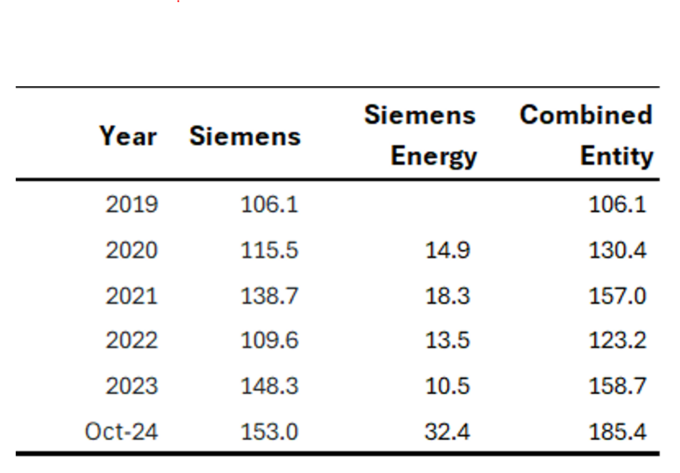
Case study
Case Study Quadrant 3
by Salvatore Cantale, Frederikke Due Olsen Published March 3, 2025 in Case study • 7 min read
Spin off ESG-heavy assets
How Siemens AG pursued a strategic split to focus on different growth trajectories
The problem
By the late 2010s, Siemens AG was grappling with a strategic dilemma common to industrial conglomerates: managing diverse business units with increasingly divergent operational needs, market dynamics, and growth trajectories. Traditionally known for its wide range of business segments, from industrial automation and medical technology to power generation, Siemens faced challenges in balancing its focus across these sectors. Among its portfolio, the energy business presented a particular set of hurdles that set it apart from other Siemens divisions.
The energy division, encompassing Siemens’ gas turbines, power generation, oil and gas, and transmission solutions, was positioned within a market in rapid transition. The industry was being reshaped by two key factors:
- Energy transition and decarbonization: With the global push towards renewable energy, there was mounting pressure on energy companies to transition away from fossil fuels and embrace cleaner, more sustainable energy solutions. Siemens’ energy division, which traditionally relied on gas turbines and fossil fuel-based solutions, needed to adapt rapidly to align with shifting industry demands toward decarbonization and renewables.
- Distinct market dynamics: The energy sector operates with unique demands, regulatory requirements, and technological investments that differ significantly from Siemens’ industrial automation and digital infrastructure businesses. This divergence presented a strategic challenge for Siemens as it sought to balance the competing priorities of driving digital transformation in its core industrial businesses and managing the complex energy landscape.
Beyond these specific energy-sector issues, Siemens AG faced a broader corporate-level challenge. Being a sprawling conglomerate meant operational complexity, which risked diluting management’s ability to focus on growth, innovation, and shareholder value. Siemens’ wide-reaching portfolio had contributed to a conglomerate discount, where investors assigned less value to Siemens compared to more focused competitors. The Financial Times wrote at that time: “Siemens hopes to erase a so-called “conglomerate discount”, which the company believes is responsible for its stock being undervalued by up to 30% per cent, as shareholders prefer simpler, more streamlined investments.”
To fully unlock the growth potential of its digital, industrial, and energy businesses, Siemens recognized that it needed a more streamlined structure that would allow each segment to operate with greater independence and agility.
The strategy
“When you’re facing a problem that is incredibly complex [like the energy transition], organizations tend to do better when they have more disaggregated decision-making to people that are closest to the problem,” said one investor, who wanted to see more green spin-offs.
Siemens’ response to this problem was a strategic split, creating two distinct entities that could pursue focused growth trajectories. This strategy would allow the core Siemens AG to focus on industrial automation, smart infrastructure, and digital industries, while Siemens Energy AG could specialize in energy, power generation, and renewables. This separation was formalized on 28 September 2020. (In a similar vein, Elliott Management, in a 10-page letter to the SSE Chair asking for corporate simplification, stated, “The market’s failure to ascribe fair value to SSE and its portfolio is directly attributable to the company’s inefficient conglomerate structure and confusing equity story. Renewables and networks are intrinsically different businesses, supported by divergent shareholder registers, with individual funding needs, growth profiles and strategic priorities.”)
The split, meticulously planned over several years, had three main components:
- Market and operational specialization: The primary aim of the split was to give Siemens AG and Siemens Energy operational autonomy to tackle their specific market environments effectively. Siemens AG would concentrate on digital and automation industries, pursuing innovations aligned with the Fourth Industrial Revolution (4IR), such as artificial intelligence, robotics, and Internet of Things (IoT) solutions. Siemens Energy, in contrast, could now direct its attention to navigating the energy transition: investing in renewable energy, developing more efficient gas turbines, and expanding sustainable power transmission solutions.
- Independent capital structures and flexibility: By becoming a standalone company, Siemens Energy gained the financial and operational freedom to make targeted investments within the energy sector without competing for resources with other Siemens AG divisions. This structure allowed Siemens AG and Siemens Energy to raise capital independently and tailor financial strategies to their distinct growth needs. Siemens Energy, for instance, could attract investors specifically interested in energy sector innovations and the transition to renewable energy sources.
- Enhanced shareholder value and transparency: Siemens executed the separation through a share distribution model. Siemens AG transferred a 55% stake in Siemens Energy to its shareholders, giving them a direct stake in the newly public company. This move provided Siemens AG shareholders with clearer visibility into the performance of Siemens Energy, while Siemens AG retained a 35.1% minority stake in Siemens Energy (with a further 9.9% held by Siemens’ pension trust). This setup aimed to maximize shareholder value, as the split allowed Siemens AG to focus on its core business lines, which were more profitable and had greater growth potential, while Siemens Energy was valued independently by the market.
The results
The results of Siemens’ strategic split became apparent as each company settled into its distinct role.
The split allowed Siemens AG to sharpen its focus on digital industries, smart infrastructure, and mobility, where the company is positioning itself as a leader in digital transformation and Industry 4.0 technologies. Siemens AG has since been able to concentrate resources on expanding its portfolio in AI, automation, and IoT, areas with substantial growth potential as more industries integrate digital solutions. Siemens AG’s strategic refocusing has led to strong financial performance and has been well-received by investors, reflecting improved share valuations and growth potential in its core industrial areas.

Stock market performance
As part of the spin-off, existing Siemens shareholders received one Siemens Energy share for every two shares they held in the parent company, giving them a 55% ownership stake in the new company at the time of its listing. The strategic split has generally been viewed positively by the markets. Siemens AG’s stock has performed well post-split, benefiting from its leaner operational focus and alignment with high-growth industrial and digital markets. Siemens Energy, while still adapting to its challenges within the energy sector, has been able to attract investor interest based on its renewable energy potential and strategic positioning within the energy transition. The pre-spin-off market capitalization of Siemens was $106.1bn at the end of 2019 (just before the spin-off). On 28 September 2020, the IPO market capitalization of Siemens Energy was set at $15bn. Siemens Energy started trading at a lower price than expected and it lost as much as 10% of its value before recovering to trade 1.2% lower than the initial IPO price at the end of the day. At the end of 2020, the combined value of Siemens and Siemens Energy’s market capitalization was $130bn and at the time of writing (October 2024) is about $185bn. In the time after the spin-off, both companies have also benefited from having distinct, focused brand identities, allowing each to communicate a clear value proposition to their respective investors and markets.
Conclusion
The strategic split of Siemens AG and Siemens Energy AG marked a turning point for the 173-year-old conglomerate, driven by a recognition of the unique challenges and growth dynamics within the industrial and energy sectors. By creating two independent companies, Siemens provided both Siemens AG and Siemens Energy with the focus, flexibility, and financial autonomy necessary to thrive in their respective markets. By separating its business into two focused entities, Siemens has provided a clear example of how a well-executed strategic restructuring can deliver operational flexibility, drive shareholder value, and position companies to lead in their respective fields.
Authors

Salvatore Cantale
Professor of Finance at IMD
Salvatore Cantale is Professor of Finance at IMD. His major research and consulting interests are in value creation, valuation, and the way in which corporations structure liabilities and choose financing options. Additionally, he is interested in the relation between finance and leadership, and in the leadership role of the finance function. He directs the Finance for Boards, Business Finance, and the Strategic Finance programs as well as the Driving Sustainability from the Boardroom program and the newly designed Bank Governance program.

Frederikke Due Olsen
Frederikke Due Olsen holds an MSc in Finance and Accounting from Copenhagen Business School (CBS) and MBA (with Honors) from IMD. With a background in equity research and short stint within university teaching, previous employers include SEB Group, Carnegie Investment Bank and CBS. Passionate about greenfield renewable energy investments, she works for Copenhagen Infrastructure Partners within its Flagship Investment Team.